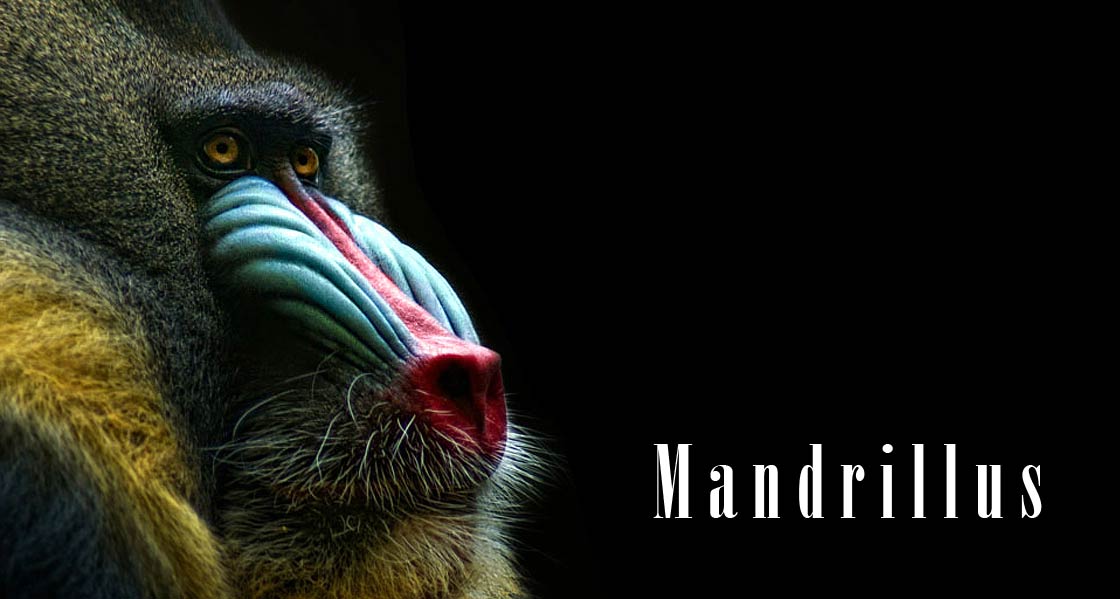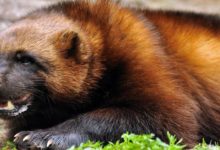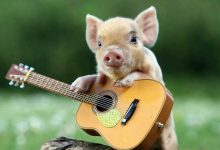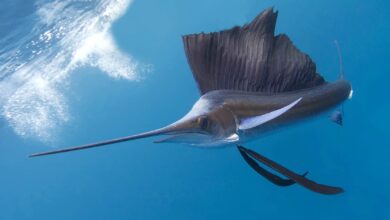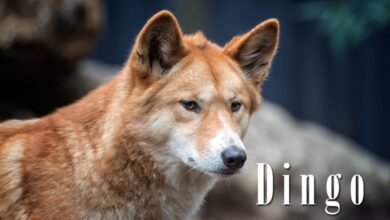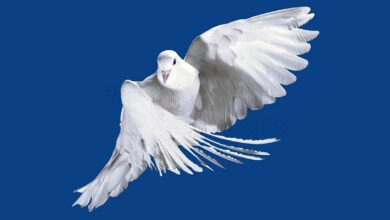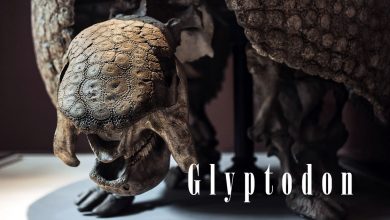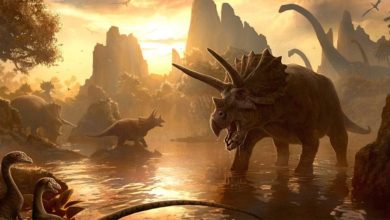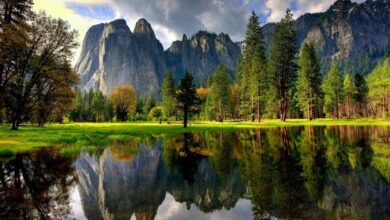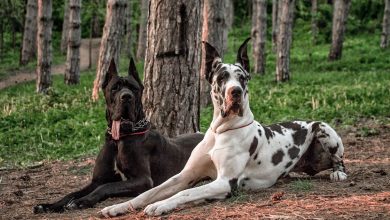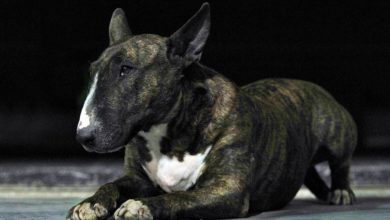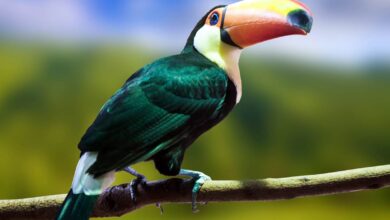Mandrill (Mandrillus sphinx)
Mandrills are one of the largest monkeys in the world. Only gorillas, chimpanzees and orangutans* surpass them with their dimensions. However, what distinguishes mandrills among other primates is their exceptionally original coloration of the face, which looks as if it has been deliberately painted.
Classification
- Kingdom: Animalia
- Phylum: Chordata
- Class: Mammalia
- Order: Primates
- Suborder: Haplorhini
- Infraorder: Simiiformes
- Family: Cercopithecidae
- Genus: Mandrillus
- Species: Mandrillus sphinx
Mandrill is the largest monkey*, closely related to baboon and drills.
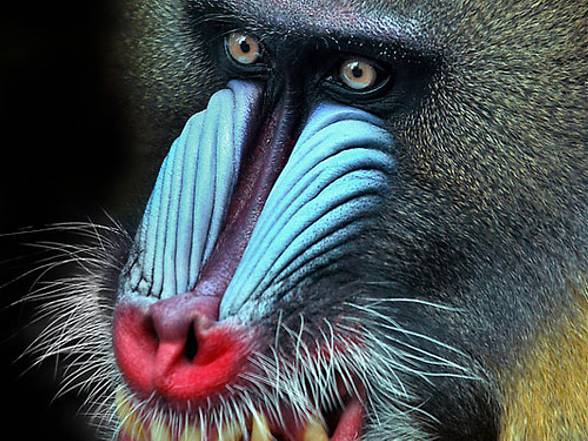
Occurrence
Mandrills are found in Africa. They live in southwestern Cameroon, western Gabon, Equatorial Guinea and south-western Congo. Their occurrence is limited by the Sanaga rivers in the north and Ogowe in the east.
The recent genetic studies of populations living north and south of Ogowe have shown that the differences between these mandrills are so significant that they could be considered as two separate subspecies.
Natural environment, habitat
Mandrills prefer tropical rain forests, dense bush, and other forestry areas. They can also be found in mixed areas, including the savannas.

Characteristics
Mandrills have a narrow muzzle, large head, and a stocky, compact body with long and strong limbs.
Mandrills also have a short tail, which is raised all the time. The wide range of collarbone rotation enables the animal to climb the trees, walk on four paws and use its arms efficiently. The opposable thumbs – like in the case of other monkeys – allow them to grasp the branches of the trees. Both male and female also have one pair of mammary glands on the chest.
The most characteristic feature of mandrill, however, is not the structure of its body, but the coloration.
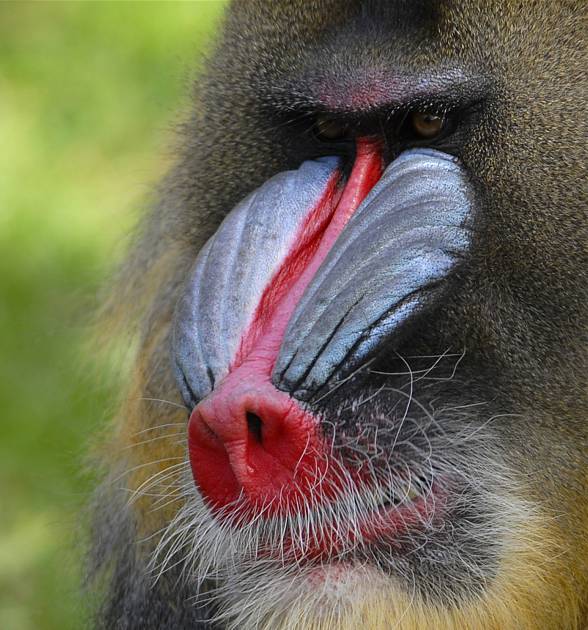
On the mandrill’s face, we can observe a narrow red strip in the middle of the mouth and around the nostrils, which on both sides was surrounded by blue, ribbed elements. The animal also has a yellow beard and red spots around the eyes.
Such colors allow distinguishing the mandrill from slightly smaller drills (Mandrillus leucophaeus) that have entire black faces.
The mandrills’ rump, especially those of the males, has also contrastive coloration, ranging from blue to purple. The whole-body hair, on the other hand, is olive with lighter spots, mainly in the head and abdomen area.
Females also have colored elements on the body, but they are much more toned-down and darker than in males.

Diet
Mandrill belongs to omnivorous animals, but its food is mainly plants – it eats more than 100 species. They prefer fruit, but also like leaves, lianas, tree bark, plant fibers, and fungi.
The predatory nature of mandrill manifests itself mainly in eating snails, beetles, ants, termites, crickets, spiders and scorpions. The animal also eats eggs, and even vertebrates such as birds, turtles, frogs, porcupines, rats, and shrews.
Mandrills occasionally hunt larger prey, such as, for example, young bay duiker (Cephalophus dorsalis), or other small ungulates. The death of their victim is most likely caused by punching into their necks long canines that can be up to 6 centimeters (2.4 in) long.
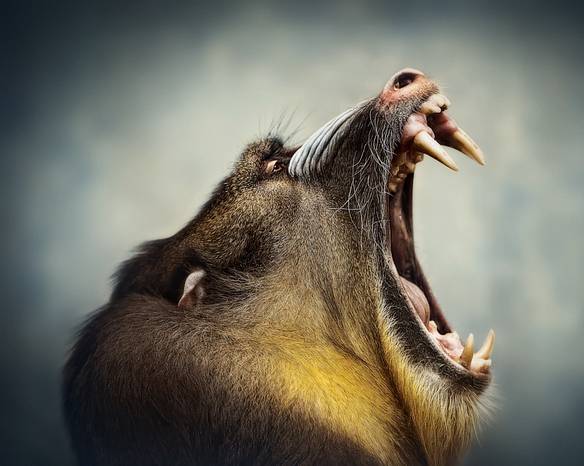
Threats
The natural enemy of the mandrill is a leopard, the African crowned eagle and one of the African python varieties. They can also be killed by biting the viper when they accidentally step on it.
However, researchers believe that most predators pose a threat to young mandrills and that the risk of becoming a prey is reduced in adult specimens. Although mandrills are more arboreal monkey species than baboons, the only factor that causes more of the herd to escape into the tree crowns is the leopard attack. Although in this case too, dominant males often remain on the ground, to demonstrate their strength.
However, researchers believe that most predators endanger the juveniles, and the risk of becoming a victim decreases in adult life. In comparison with the baboon, mandrill is rather arboreal species. It is due to the attacking leopards that most of the flocks escaped to the trees. Although in this case the dominant males often stay on the ground in order to demonstrate their strength.
Mandrills are endangered by extinction. This is mainly due to human activities – destruction of the natural environment (deforestation) and excessive hunting, especially in Congo. Unfortunately, a reintroduction of these monkeys (bred in captivity and released) has not yet succeeded.

Lifestyle, social behavior
Although mandrills can perfectly climb trees, they are mainly ground-based species. They move on four legs and only cover short distances by running on two hind legs. They are active during the day, in the afternoon they rest in shady places and sleep on trees. They spend each night in a different place.
Social structure
Mandrills form large groups called hordes. Often, they count hundreds of individuals – they can be even about 1000. The largest observed herd of these animals consisted of 1300 pieces. Groups are formed by females with young mandrills. The males lead a lonely life and join the horde only during the heat period. There is no evidence that there are typically male groups like in the case of other animal species.
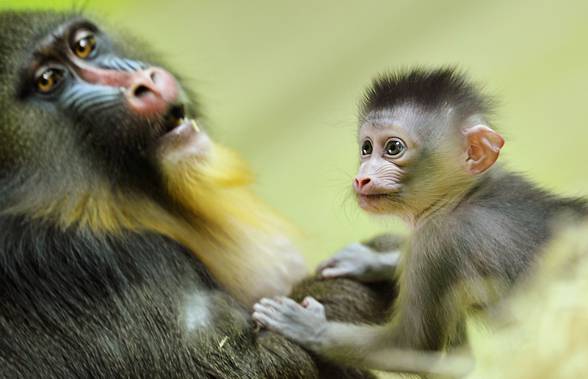
Reproduction
The mandrills’ mating season falls on the time between June and October. There may be fights between males, because only the dominant individuals have a chance to find a partner. The strength of mandrill manifests itself, among others in their coloration, which becomes even more vivid.
The female can reproduce every two years. Pregnancy usually lasts 175 days and birth takes place in the period from January to May. Usually, one baby is born with a weight of 350 grams (0.8 lb). Females take care of the baby, which are attached to the abdomen at first and then to the back.
The young become independent after one year, and sexual maturity after 4-6 years from birth. A full coloration develops at this time. In the wild, mandrills live up to 20 years.
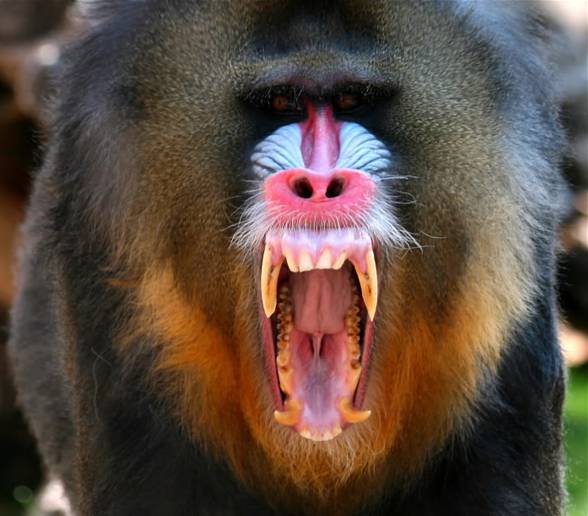
Detailed data / dimensions
Mandrill (Mandrillus sphinx)
In males, sexual dimorphism is very strong – males are larger and usually weigh twice as much as females.
- Length:
- males – from 75 to 95 cm (30 – 37.4 in)
- females – 55 to 66 cm (21.6 – 26 in)
- Tail length: 5 to 10 cm (2 – 4 in)
- Height at shoulders on four paws:
- males – from 55 to 65 cm (21.6 – 26 in)
- females – from 45 to 50 cm (17.7 – 19.7 in)
- Weight:
- males: from 19 to 37 kg (42 – 82 lb); on average – 32 kg (70 lb); record specimens up to 54 kg – 119 lb but unconfirmed reports of mandrills weighing 60 kg (130 lb)
- females: 10 to 15 kg (22 – 33 lb); on average 12.5 kg (27.6 lb)
- Canines’ length:
- males: up to 6.35 cm (2.50 in); on average 4.5 cm (1.8 in)
- females on average: 1 cm (0.4 in)
- Lifespan: 20 years in the wild, up to 31 years in captivity.
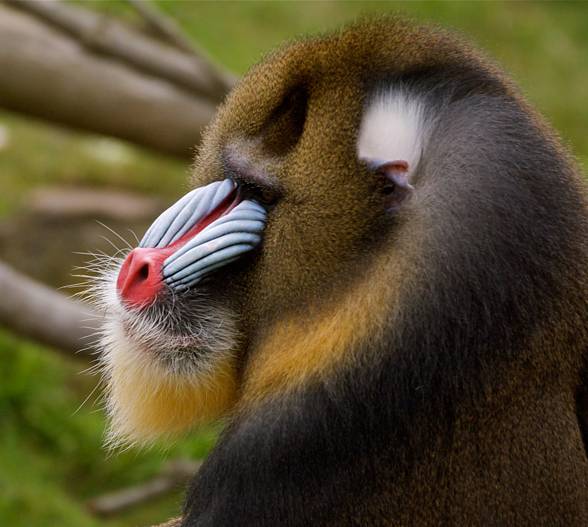
Mandrill (Mandrillus) – curiosities
- In his book “The Descent of Man that”, Charles Darwin wrote: “no other member in the whole class of mammals is colored in so extraordinary a manner as the adult male mandrill’s“
- In captivity, mandrills can live up to 31 years.
- The canines of the males’ can reach as much as 6.35 cm (2.5 in) of a length
- Mandrill is the largest and heaviest monkey. Only apes are larger.
- The mandrill is classified as vulnerable by IUCN.
* Mandrill is a primate of the Old World monkey and gorillas, chimpanzees and orangutans are apes, but apes are the branch of Old World monkeys.


